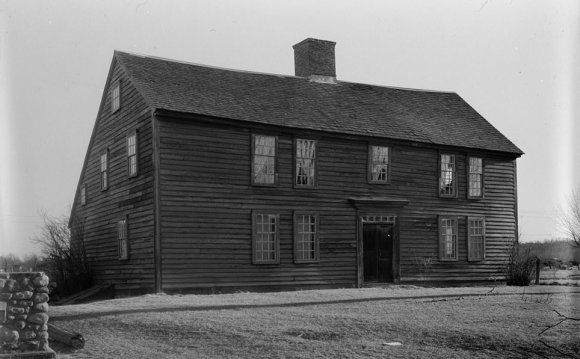

FIRST PERIOD
- When 1600-1700
- Where Boston (such as the Paul Revere House in the North End), Ipswich, Newburyport, Salem (including the House of the Seven Gables)
- What Also known as Post-Medieval style, First Period houses are the ur-Colonials, with an iconic boxy shape, a steeply pitched roof to keep snow from accumulating, and a large central chimney to heat the entire one-room-deep interior. They were not designed by architects but rather were built by early Colonists to echo the houses they lived among in Europe, particularly southeastern and central England. Most are sided with narrow clapboards and have casement windows with multiple panes.
GEORGIAN
- When 1700-1780
- Where Boston (notably the Old Corner Bookstore in Downtown Crossing), Concord, Marblehead, Newburyport, Salem
- What Fashionable during the reign of England’s King George III, Georgian style is based on the well-proportioned, symmetrical ideals of 16th-century Italian architect Andrea Palladio. Palladian patterns were published in tradesmen’s books and then brought to the New World, where the style proliferated with both brick and wood sidings. Most Georgian houses in New England are two rooms deep and two stories high, with chimneys at each end instead of in the center. “In the Boston area we’re fortunate to have large numbers of Georgian and Federal-style houses still intact, ” says Cornish. “In other parts of the country, you don’t have that.”
FEDERAL
- When 1780-1820
- Where Boston (particularly Beacon Hill and the State House), Marblehead, Newburyport, Salem
- What Because the nation’s founding fathers consciously chose to emulate the look of ancient Greece and Rome, architects were needed, and Boston’s own Charles Bulfinch was among the most prominent. They planned buildings that were similar in shape to the Georgian style and still strictly symmetrical but more refined, with low-hipped roofs, decorative molding on the cornices, and delicate fanlights over the front doors. The interiors had more creative floor plans and embellishments, including swags, garlands, urns, and classical geometric patterns.
GREEK REVIVAL
- When 1815-1860
- Where Amherst, Andover, Barnstable, Boston (notably Mount Vernon and Pinckney streets, Quincy Market, and Union Park), Cambridge (such as Inman Square and Otis Street), Jamaica Plain
- What The classical theme continued and intensified with the robust and muscular Greek Revival style, which was often used for public buildings but also for domestic architecture that spread from the cities to the provinces. Its most prominent feature is its columns, either real — beneath a porch or a heavy pediment — or echoed in wide corner boards often capped with Doric, Ionic, or Corinthian details. The roof is typically situated gable-end forward, with one or more chimneys set back, and, though the style is generally symmetrical, the entryway is often on one side and accentuated with narrow sidelights and a rectangular transom.
GOTHIC REVIVAL
- When 1840-1880
- Where Dorchester, Martha’s Vineyard (particularly Oak Bluffs), Roxbury, Yarmouth
- What “I’ve always had a fondness for Italianate and Gothic Revival, ” says Historic New England’s Cornish. “They’re romanticized mid-19th-century revival styles that were really very important to tying the site and landscape and setting to the house and trying to incorporate indoor and outdoor living spaces.” Gothic architecture was used in the medieval cathedrals of England and northern France, and its rebirth in the United States rejected classicism and embraced naturalism. Its steeply pitched rooflines often dripped with intricate moldings on deeply overhanging eaves. Windows, which typically extended into the gable, and doors were commonly topped with pointed molding arches, and one-story full-width or entry porches were sometimes detailed with fancy woodwork.
ITALIANATE
- When 1840-1885
- Where Back Bay, Boston (such as Concord Square), Dorchester (notably Savin Hill Avenue), Jamaica Plain, Lowell, Lynn, New Bedford, Roxbury
- What Italianate, like Gothic Revival, grew out of the Picturesque movement in Europe, which focused on the irregularity of nature and drew its inspiration from the landscape. In this country, the houses had somewhat irregular shapes that sometimes incorporated square towers and cupolas. Ornamentation included wide, bracketed eaves; arched double or triple windows, often bay-shaped, tall, and narrow; paired, frequently arched doorways; structural masonry or decorative wood corner quoins; and centered or full-width porches.
ROMANESQUE REVIVAL
- When 1840-1900
- Where Boston (notably St. Germain Street), Brookline (particularly Beacon Street), Fall River, Holyoke, Lynn, Newton, Worcester
- What Less common for housing in the Boston area, Romanesque Revival is exemplified in Back Bay’s Trinity Church, designed by the foremost practitioner of Romanesque style, H.H. Richardson, and in the Engine 33 and Ladder 15 firehouse on Boylston and Dalton streets, also in the Back Bay. Richardson’s designs were published after his death in pattern books and builders’ guides, and the style was taken up for residences as well. Romanesque buildings are marked by their large round towers and prominent arches; many are constructed of masonry, though wood-framed examples are not unheard of.
SECOND EMPIRE
- When 1855-1885
- Where Boston (notably Appleton Street), Brookline, Cambridge,
- What Second Empire houses are pretty much everywhere; they took off with the post-Civil War population explosion and the invention of the streetcar, which made suburbs more accessible. With the economy booming and house plans becoming more complex, Second Empire style, adapted from French architecture and named after the reign of Napoleon III, became popular, with its two to four stories, straight or flared mansard roofs containing many dormers, expansive porches, and rectangular towers centered on the front facade. Decorative touches included stained-glass windows, fanciful ironwork, and bracketed eaves.
STICK STYLE
- When 1860-1890
- Where Fall River, Lowell, Newton, North Adams, Springfield
- What Stick Style is “a very specific design, ” says Neiswander, “in which the exterior walls have boards that divide their surface vertically and horizontally with clapboard in between.” Stucco can also be between those boards. Often said to link Gothic Revival and Queen Anne, Stick Style also overlapped with Tudor Revival. It emphasized asymmetrical two- or three-story forms, complex gable roofs with overhanging eaves, decorative trusses at gable ends, exposed rafter tails, and corbeled chimneys.
Source: www.bostonglobe.com
RELATED VIDEO

House For Sale In New England

Philippines House Style

New England House









